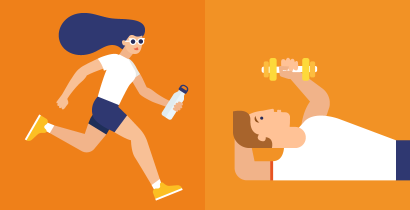9 Proven Benefits of Physical Activity
Last Updated : 12 February 2020Physical activity refers to all the movement we carry out throughout the day, such as doing housework, bring in shopping, walking to work and doing exercise like playing a sport or going to the gym. Evidence continues to mount that being physically active can benefit both body and mind, as well as reducing the risk of many diseases. Here are nine proven benefits of regular physical activity.

Figure 1. The benefits of physical activity
1. Helps maintain a healthy body weight
Low physical activity can increase someone’s risk of becoming overweight or obese. 1 While exercising alone does not necessarily lead to weight loss, in combination with a balanced calorie-controlled diet, it can support successful weight reduction. In addition, there is evidence that regular physical activity can help maintain a healthy body weight over time. 2
2. Lowers blood pressure
High blood pressure (or hypertension) is a risk factor for many diseases, particularly stroke and heart disease. Regular physical activity can increase your hearts strength, which reduces the effort needed to pump blood around the body. This decreases the force on your arteries, reducing blood pressure. There is good evidence that regular physical activity helps maintain a healthy blood pressure. 1, 3
3. Decreases the risk of heart disease
Regular exercise, especially aerobic exercise, such as brisk walking, running and cycling, has been shown to reduce the risk of developing heart disease. 1, 3 This benefit is observed for people of all body sizes. People with overweight or obesity who are physically active are far less likely to get heart disease compared to those who aren’t.
4. Lowers the risk of type 2 diabetes
Exercise is known to help in the regulation of blood sugar levels and improves our bodies sensitivity to insulin. Physical inactivity, on the other hand, has been consistently shown to increase the risk of developing type 2 diabetes. 1, 3 Furthermore, regular exercise is often recommended to people with diabetes to aid in their control of blood sugar levels.
5. Reduces the risk of certain cancers
Cancer is a complex disease influenced by many controllable (e.g. smoking, unhealthy diet, high alcohol consumption) and uncontrollable (e.g. genetics, radiation, environmental pollutants) factors. Evidence suggests that regular moderate to vigorous exercise can help reduce our risk of developing certain types of cancers, including colon, colorectal, lung and breast cancers. 1, 4
6. Increases muscle strength and function
Skeletal muscle serves many functions, it helps maintain posture, controls movement and generates body heat. As we age, our muscle mass tends to decrease, often due to a more sedentary lifestyle. This loss of muscle mass can reduce our mobility and increase our risk of falls and muscular diseases such as sarcopenia. 5 Regular exercise, particularly resistance training (such as lifting weights or bodyweight exercises such as squats and push-ups) can help improve muscle strength and resilience and reduce our risk of muscular disorders like sarcopenia. 3, 5
7. Improves bone health and strength
Weight-bearing exercise (e.g. running, dancing), as well as resistance training, have been shown to improve bone density in adolescents and help maintain bone density in adulthood, reducing the risk of osteoporosis 1 This is particularly important for older adults and menopausal women as it can help to slow the natural loss of bone density that occurs with age.
8. Helps to promote positive mental health
Regular exercise has been shown to have a positive effect on our mental health and psychological well-being. 1 The exact mechanism for which exercise benefits our mental health is not fully understood. What is known is regular exercise can promote the release of endorphins as well as help relieve stress and promote a healthy sleep pattern, which can all work together to improve our mood. In addition, there is some evidence to suggest that exercise may even help in the treatment of depression and other mental disorders. 6
9. Reduces the risk of dementia
Regular exercise has been consistently shown to protect against cognitive decline. 1 Although it is still not fully understood how exercise reduces cognitive decline, recent evidence suggests that the release of proteins known as neurotrophic factors likely play an important role. These beneficial factors help promote neuron growth and repair which help support normal cognitive functioning. 7 This may partly explain why older adults who remain physically active throughout life have a much lower risk of developing cognitive disorders such as dementia and Alzheimer's disease. 7, 8
How much physical activity should we do?
The World Health Organisation recommends: 1
- We do a minimum of at least 150 minutes of moderate-intensity aerobic physical activity throughout the week or at least 75 minutes of vigorous-intensity aerobic physical activity throughout the week or an equivalent combination of moderate- and vigorous-intensity activity.
- Aerobic activities should be performed in bouts of at least 10 minutes duration.
- For additional health benefits, adults should aim to increase their moderate-intensity aerobic physical activity to 300 minutes per week, or 150 minutes of vigorous-intensity aerobic physical activity per week, or an equivalent combination of both moderate- and vigorous-intensity activity.
- Muscle-strengthening or anaerobic activities should be done involving major muscle groups (legs, hips, back, abdomen, chest, shoulders and arms) on 2 or more days a week.
For people with prior health conditions, it is advised they consult a health professional before undertaking additional exercise.

Figure 2. Moderate vs vigorous physical activity.
Tips to increase your physical activity
In today’s busy society, regular physical activity can be hard to maintain and requires both time and effort. Here are some tips to help you increase your physical activity levels:
- Set realistic goals: making a commitment to increase your physical activity is an important first step. Setting a goal (e.g. get 10,000 steps every day) and planning what you need to do to achieve this goal (e.g. plan to walk part of your commute) can help keep you focused and committed.
- Take the stairs: An easy way to increase your daily physical activity is to take the stairs instead of lifts or elevators wherever possible.
- Get your friends involved: Exercise is better with friends, try joining a sports team or going for a run or brisk walk with a friend.
- Walk part of your commute: Try getting off a stop early or parking further away and walking part of your commute.
- Take regular breaks from sitting: Many of us spend most of our days seated, be it at work or at home. Try to take regular breaks to walk around and stretch your legs and avoid sitting for long periods.
- Make it fun: Exercise shouldn’t be a chore, much like eating a healthy balanced diet, if we don’t enjoy it we won't be able to keep it up for long. Try to find an activity that you enjoy and can stick to long-term.

Figure 3. Tips to increase your physical activity.
In Summary
It seems clear that physical activity has several health benefits. However, we must not forget that it is just one part of a healthy lifestyle and for good health, we should also focus on eating a balanced diet that is rich in fruits and vegetables, whole grains, some dairy, nuts, pulses, eggs, lean meat and oily fish, and limit our intake of saturated fat, sugars and salt.
Further reading
For more information see physical activity and health.
References
- World Health Organisation (WHO), 2010. Global recommendations on physical activity for health. Geneva, Switzerland: WHO.
- Swift, D.L., McGee, J.E., et al., 2018. The effects of exercise and physical activity on weight loss and maintenance. Progress in cardiovascular diseases, 61(2), pp.206-213.
- Warburton, D.E. and Bredin, S.S., 2017. Health benefits of physical activity: a systematic review of current systematic reviews. Current opinion in cardiology, 32(5), pp.541-556.
- World Cancer Research Fund/American Institute for Cancer Research. Continuous Update Project Expert Report, 2018. Physical activity and the risk of cancer.
- Cruz-Jentoft AJ, Sayer AA (2019). Sarcopenia. The Lancet. 393 (10191): 2636-2646.
- Stubbs, B., Vancampfort, D. et al., 2018. EPA guidance on physical activity as a treatment for severe mental illness: a meta-review of the evidence and Position Statement from EPA, supported by OPTMH. European Psychiatry, 54, pp.124-144.
- Tari, A.R., Norevik, C.S., et al. 2019. Are the neuroprotective effects of exercise training systemically mediated?. Progress in cardiovascular diseases.
- Livingston, G., Sommerlad, A., et al. 2017. Dementia prevention, intervention, and care. The Lancet, 390(10113), 2673-2734.



